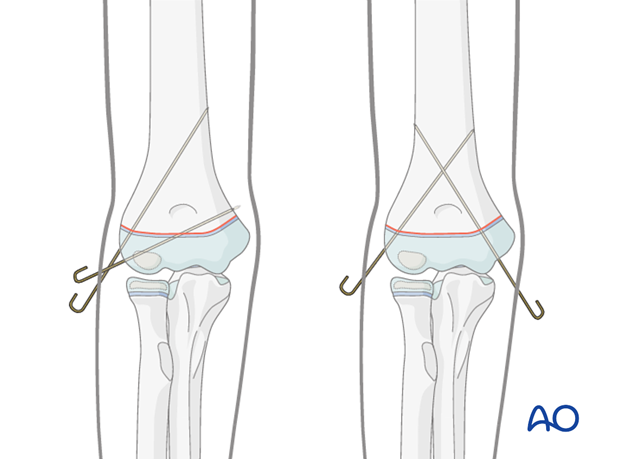Closed reduction; K-wire fixation
1. Introduction
Separation of the distal humeral epiphysis is a very rare injury that happens mostly in newborns and children up to 2-3 years of age.
Above this age typical supracondylar fractures are mainly seen.
Especially in the first year of life and in newborn babies, this lesion is misdiagnosed as an elbow dislocation.
Note: This type of injury has a high incidence of nonaccidental injury.

The main goals for treatment of these physeal separations are:
- No secondary damage
- Pain management
- In case of mobile epiphysis, gentle reduction to the metaphysis and K-wire fixation
- Primary healing
- No secondary displacement
2. Preparation
Instruments and implants
It is recommended to use 1.0 or 1.2 mm K-wires.
The following equipment is needed:
- K-wires (1.0 or 1.2 mm)
- Drill (in case K-wire is not inserted by hand), preferably oscillating to avoid thermal injury, or T-handle
- Wire cutting instruments
- If necessary, contrast medium for arthrography

Pearl: As nearly 90% of the epiphyseal fragment is cartilage, it is also possible to insert the K-wire by hand. For this, the K-wire is formed into the shape of a Z or U (see illustration).

Anesthesia and positioning
For children, general anesthesia is always recommended. Muscle relaxation is not necessary.
The patient should be placed supine with the arm draped up to the shoulder.

3. Technique
Arthrography is indicated when the fragment cannot clearly be identified.
No force is necessary to realign the epiphyseal fragment with the shaft. Forceful maneuvers could damage the physis.

Insertion of first K-wire
The first K-wire is inserted directly through the skin into the fragment from very distal on the lateral side.
Before passing the fracture line, check that alignment of the fragment to the metaphysis is adequate. The K-wire is advanced into the metaphysis (by hand or with a drill).

Insertion of second K-wire
It is recommended to also insert the second K-wire from the lateral side. However, this wire is inserted more obliquely.

If the second K-wire is inserted from the medial side, it is recommended to visualize the insertion point with a small incision. This is to decrease the risk of damaging the ulnar nerve and ensures an appropriate insertion point.

The K-wires are bent and cut outside the skin.

4. Aftercare
A posterior splint is applied

If the child remains for some hours/days in bed, the elbow should be elevated on pillows to reduce swelling and pain.
See also the additional material on postoperative infection and compartment syndrome.

The postoperative protocol is as follows:
- Time in hospital according to local practice (1-3 days
- First clinical and radiological follow up, depending on the age of the child, 2-3 weeks postoperatively out of the cast
- In most cases, at this first x-ray control, the fracture is consolidated and stable so that the cast is no longer required and the K-wires can be removed
- Physiotherapy is not usually indicated













